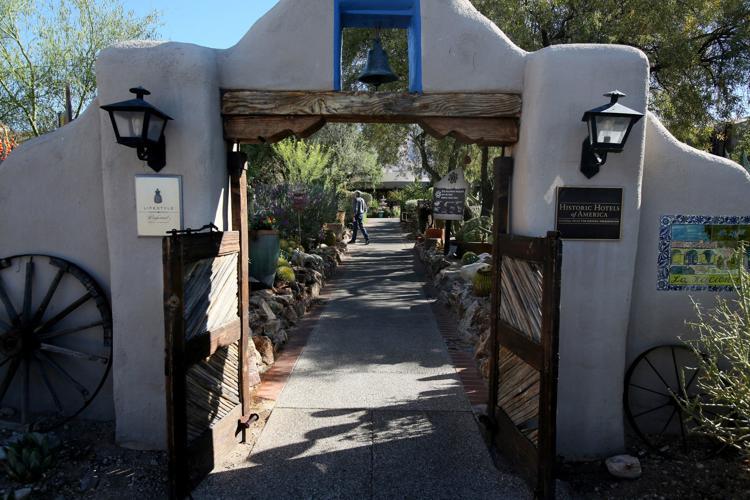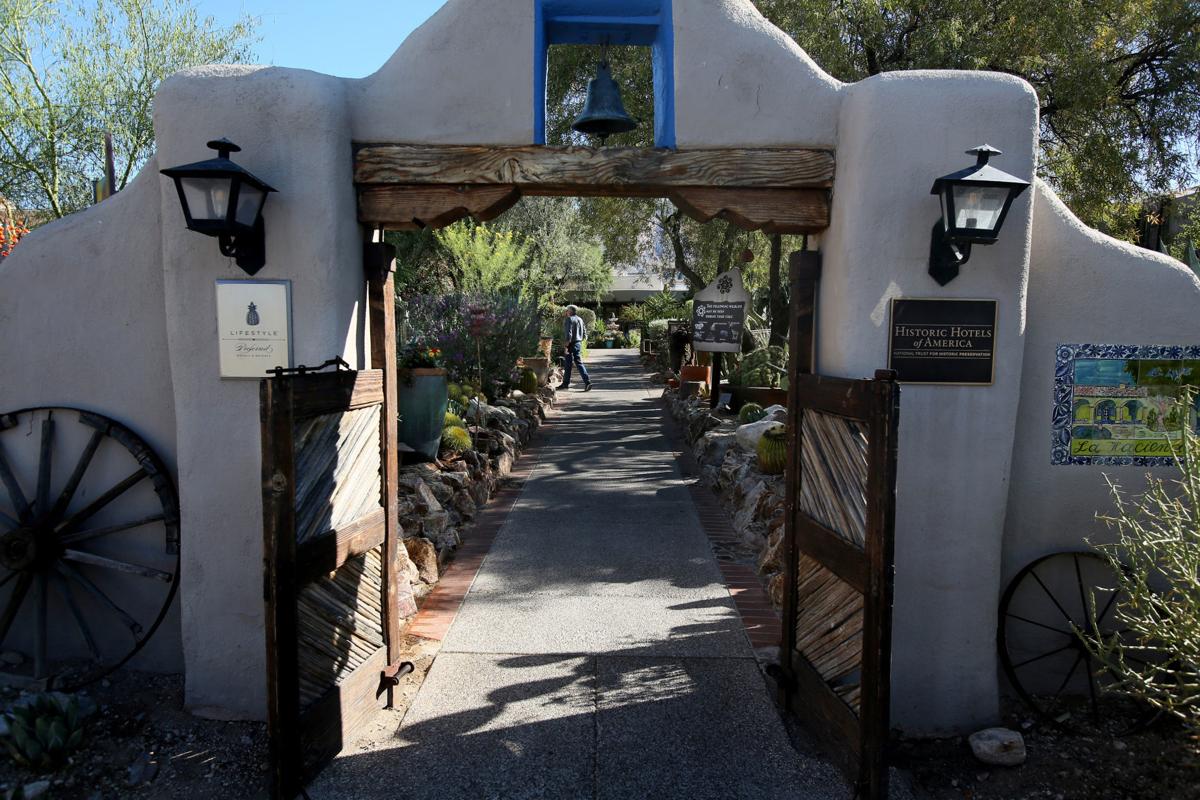There are several public gardens and parks in the Tucson area that help you understand what can grow in the Sonoran Desert.
But sometimes hidden gardens sit in plain sight. They may look like mere landscaping, but with a few signs or an organized tour, they, too, can explain why they do well in our tough growing environment.

Signs help guests determine plant species in the gardens at Hacienda del Sol Guest Ranch Resort, 5501 N. Hacienda del Sol Road, Tucson, on May 18, 2018.
HACIENDA DEL SOL
GUEST RANCH RESORT
The gardens and landscaping at this former ranch school recently was named among the “Top 25 Most Magnificent Gardens” among the more than 300 members of Historic Hotels of America.
Many of the native cactus and trees have been around since the school opened in 1929, set in a natural desert setting.

Since 1998, he’s helped expand the gardens at Hacienda del Sol.
New gardens have been developed and groomed since Frank Hughes joined the Foothills resort as a partner in 1998.
He and Jeff Timan, one of the 1995 buyers of the property, are neighbors and share a love for gardens and plants. Timan’s other title at the resort is director of gardening and art.
Together, they’ve expanded the gardens to include non-native cactus, particularly from tropical areas of the world, as well as an organic chefs garden, a bartender’s garden and a citrus grove.
For years, lodgers from around the world took pictures of the native vegetation and asked resort workers to identify the plants that they may have been seeing for the first time. The questions grew as the landscape added more plants, including succulents from around the world.

This cactus garden is one of the newer landscaping features at Hacienda del Sol Guest Ranch Resort. The resort recently added dozens of signs to help visitors identify plants.
“(Questions) got more and more frequent,” says Hughes. “They are so interested in these different life forms.”
Recently, to help guests out, the resort added signs to 37 plants.
“It’s been on our to-do list for a number of years,” he says.
Hughes and the gardening staff — Alfonso Benitez, Edgar Valdez and head gardener Melanie Zettel — tapped resources at the University of Arizona Cooperative Extension and the Tucson Cactus and Succulent Society to get the botanical and common names of the plants. In a first phase of the project, they ordered signs with both names and staked them in front of specimens good enough to be focal points in the landscape.
Garden strollers can now tell if they’re looking at an Engelmann’s prickly pear or an Indian fig prickly pear, an octopus or a spider agave, a saguaro or an organ pipe cactus.
Plants other than succulents also are identified, such as palo verde and Texas olive trees, and desert milkweed.
Hughes and Timan have also worked to create set pieces within the landscape. For instance, the fountains that have remained from the school are surrounded by non-native annuals in colorful Talavera pottery.

Potted annuals provide splashes of color in the gardens at Hacienda del Sol Guest Ranch Resort, 5501 N. Hacienda del Sol Road.
The interior courtyard used to have in-ground non-native annuals around the large grassy area. Now the ground is covered with cactus, while the non-native annuals add color while growing in pots. They trim artificial grass.
At the entrance of the restaurant, the right side with old growth of bougainvilleas is balanced on the left side with tall Mexican fence posts.
The chef’s garden, which also is open for public inspection, grows seasonal crops. The new bartender’s garden acts as landscaping for the restaurant patio and has chocolate mint, pineapple basil, chive, nasturtium and lemon grass. These and other edibles are used by bartenders who concoct new cocktails and garnish beverages.
The next phase of the project is to put up identification signs for the 30 citrus trees that yield Meyer lemon, variegated lemon, ruby red grapefruit and Valencia orange. Those also were added once Timan and Hughes got their hands on the landscape.
By fall, a map should additionally help visitors find plants on the property.
For more information: www.haciendadelsol.com
PRESIDIO SAN AGUSTIN
DEL TUCSON MUSEUM
The plants in the Tucson presidio museum downtown don’t look out of place, but they’re specially selected to represent the area’s history from Spanish colonization to Territorial settlement.
“We tried to put a little sample of all of the trees that the colonists would have brought with them,” says Mary M. Graf, a museum volunteer responsible for the landscape.
That would include the 11 plants that have interpretive signs: pomegranate, quince, apricot, mission grape, mission fig, mission olive, honey mesquite, jujube, Lady Banks rose, sweet orange and Lisbon lemon.
Each sign gives the botanical, English, Spanish and Tohono O’odham name of the plant and how it played a role in Tucson history.
There’s also an edible garden that shows some of the New World plants that made their way back to Europe, including chiltepin, tomato and corn.
Admission into the museum is $5. For more information online: tucsonpresidio.com

The University of Arizona campus in bloom. The campus has over 400 tree species.
UNIVERSITY OF ARIZONA
It just looks like landscape, but the flora around the University of Arizona are part of an official UA Campus Arboretum created in 2002.
The designation from the American Public Garden Association recognizes the long history of research and preservation of the plants on campus.
Heritage and notable trees include the first African sumac planted in Tucson, the largest southern live oak in Tucson and Tucson’s only gold shower tree.
Non-native cactus, olive trees and forage grasses found on campus stem from agricultural research projects.
There are 11 arboretum tours. You can follow along with stop-by-stop tours available on a mobile device. Or you can print maps from the website. Printed tour brochures can be borrowed from the UA Campus Arboretum office at Herring Hall on campus.

A QR code read by a smartphone broadens the amount of information you can learn about these Engelmann’s hedgehog cacti in the Joseph Wood Krutch Garden on the UA Mall.
The self-guided walks are divided into themes, including trees around the world, university history, edible landscapes, medicinal plants and landscape horticulture. Other tours focus on regionally related plants from the tropics, Mediterranean and Sonoran Desert.
The newest tour is of the Environment and Natural Resources 2 Building (ENR2). The structure architecturally and botanically simulates a slot canyon.
Regularly scheduled guided tours are held during the school year. Group tours can be arranged for the summer with two weeks’ notice.
For more information online: arboretum.arizona.edu

Students relax under an African sumac in front of the Arizona State Museum at the UA.










